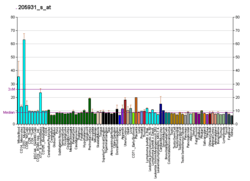CREB5
Cyclic AMP-responsive element-binding protein 5 is a protein that in humans is encoded by the CREB5 gene.[5][6][7]
The product of this gene belongs to the CRE (cAMP response element)-binding protein family. Members of this family contain zinc-finger and bZIP DNA-binding domains. The encoded protein specifically binds to CRE as a homodimer or a heterodimer with c-Jun or CRE-BP1, and functions as a CRE-dependent trans-activator. Alternatively spliced transcript variants encoding different isoforms have been identified.[7]
References
- 1 2 3 GRCh38: Ensembl release 89: ENSG00000146592 - Ensembl, May 2017
- 1 2 3 GRCm38: Ensembl release 89: ENSMUSG00000053007 - Ensembl, May 2017
- ↑ "Human PubMed Reference:".
- ↑ "Mouse PubMed Reference:".
- ↑ Zu YL, Maekawa T, Nomura N, Nakata T, Ishii S (Oct 1993). "Regulation of trans-activating capacity of CRE-BPa by phorbol ester tumor promoter TPA". Oncogene. 8 (10): 2749–58. PMID 8378084.
- ↑ Nomura N, Zu YL, Maekawa T, Tabata S, Akiyama T, Ishii S (Mar 1993). "Isolation and characterization of a novel member of the gene family encoding the cAMP response element-binding protein CRE-BP1". J Biol Chem. 268 (6): 4259–66. PMID 8440710.
- 1 2 "Entrez Gene: CREB5 cAMP responsive element binding protein 5".
External links
- Human CREB5 genome location and CREB5 gene details page in the UCSC Genome Browser.
Further reading
- Gerhard DS, Wagner L, Feingold EA, et al. (2004). "The Status, Quality, and Expansion of the NIH Full-Length cDNA Project: The Mammalian Gene Collection (MGC)". Genome Res. 14 (10B): 2121–7. doi:10.1101/gr.2596504. PMC 528928. PMID 15489334.
- Ota T, Suzuki Y, Nishikawa T, et al. (2004). "Complete sequencing and characterization of 21,243 full-length human cDNAs". Nat. Genet. 36 (1): 40–5. doi:10.1038/ng1285. PMID 14702039.
- Hillier LW, Fulton RS, Fulton LA, et al. (2003). "The DNA sequence of human chromosome 7". Nature. 424 (6945): 157–64. doi:10.1038/nature01782. PMID 12853948.
- Strausberg RL, Feingold EA, Grouse LH, et al. (2003). "Generation and initial analysis of more than 15,000 full-length human and mouse cDNA sequences". Proc. Natl. Acad. Sci. U.S.A. 99 (26): 16899–903. doi:10.1073/pnas.242603899. PMC 139241. PMID 12477932.
- Harrington JJ, Sherf B, Rundlett S, et al. (2001). "Creation of genome-wide protein expression libraries using random activation of gene expression". Nat. Biotechnol. 19 (5): 440–5. doi:10.1038/88107. PMID 11329013.
- <Please add first missing authors to populate metadata.> (1999). "Toward a complete human genome sequence". Genome Res. 8 (11): 1097–108. doi:10.1101/gr.8.11.1097. PMID 9847074.
This article is issued from
Wikipedia.
The text is licensed under Creative Commons - Attribution - Sharealike.
Additional terms may apply for the media files.




